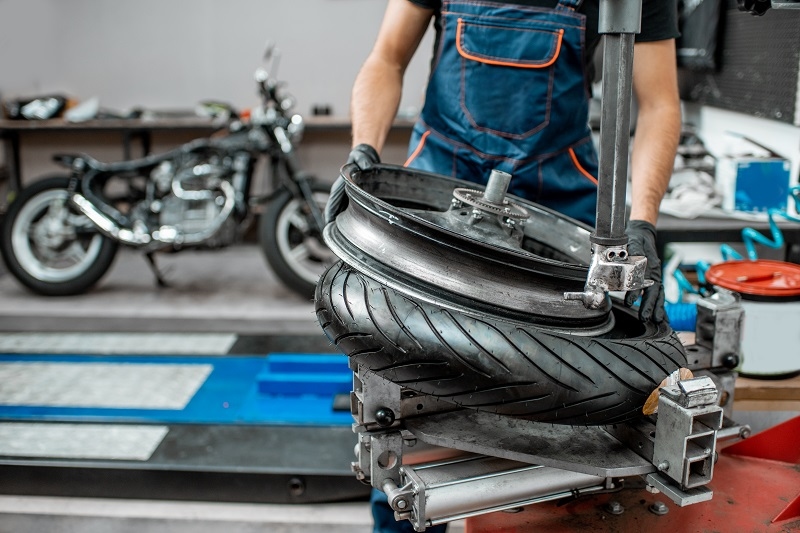
Having your motorbike at home is convenient and cost-effective, especially if you own the appropriate tools to work with it. If you need to do a quick oil change, inspect the chain, or are about to embark on a lengthy trip, a motorbike garage ramp is an absolute necessity. Ramps enable you to lift the motorbike securely, providing great access to its necessities.
This blog will discuss why garage ramps are essential for motorcycle maintenance, the different types available, how to use them safely in a U.S. garage, and how to ensure you use the correct ramp for your needs. It will highlight some U.S. bike lift tips, cover ramp weight ratings, and explain how to build a secure setup with safe bike lifting tools.
Without a ramp, even the easiest repair is bothersome or unsafe. Stabilizing a bike on its kickstand to examine or replace parts isn't only time-consuming—it's unsafe. These ramps hold your motorcycle level and off the ground so you can accomplish tasks with stability and confidence. Oil change, tire replacement, or almost any other task is easy with a motorcycle maintenance ramp, which minimizes bodily stress and prevents damage to your bike.
Some of the key benefits of using a ramp are:
There are different types of motorcycle ramps for various functions. Some are basic platforms, and some utilize hydraulic or air pressure to lift. Your choice depends upon your motorcycle type, garage space, and budget.
Fixed ramps are single-piece, permanent ramps made of steel or aluminum. They are most suitable for garages where there is space to have them installed and stay in place forever. They are sturdy and give a strong inclination for effortless tasks such as cleaning or checking.
Folding ramps suit home garages where there is limited space available. They are foldable, lightweight, and portable when not in use. Although less stable than permanent models, they are suitable for most standard motorcycles and are very simple to store.
A hydraulically fitted motorcycle workshop ramp provides smooth and accurate lifting. They are typically pricey but have excellent stability and height adjustment. Hydraulic lifts are typically favorites among serious bikers and home experts who maintain their cars on a regular basis.
These lifts raise the platform with the assistance of compressed air. They are robust and perfect for heavy bicycles. In case your American garage already has an air compressor, an air-powered ramp would be a wonderful long-term option.
Scissor lifts lift the bike using a foot-operated or hydraulic system that hoists a cross-type frame. They are small and stable and fit perfectly for mid-sized bicycles. Scissor lifts are perfect for do-it-yourselfers who require both performance and affordability.
Each of these items has advantages. The secret is selecting the one that suits your style of riding, the size of your bicycle, and how much maintenance you will be doing in your house.
Garage ramp weight rating is the amount of weight that the ramp can carry safely. This is quite possibly the most critical thing to look for when purchasing any type of ramp or lift.
Motorcycles range from light sport bikes to heavy touring bikes. Additional accessories, bags, or a full fuel tank will cause the weight to add up. Your ramp should be able to support this entire weight comfortably.
A falling ramp when loaded with your bike weight can cause injuries and damages. Always consider the weight rating of the garage ramp prior to lifting.
Lifting a motorbike is more than just putting it down the ramp. You require other safe bike lifting equipment to support and hold the bike when you lift it.
Some of the accessories that you need are:
These accessories will secure your work area better, particularly in small garages with limited space. A couple of accessories can actually provide your bike a great balance on the ramp.

Getting the appropriate ramp is only half the story. You need to properly install it in your garage to make it function properly and efficiently.
Here is the way to set up a good ramp setup for bikes in a typical U.S. home garage:
Position your ramp on a flat, even floor. Buckled floors will make it unstable. Do not position it on slippery areas or oil spill surfaces.
Leave yourself some space to move around the motorcycle. Have at least 2–3 feet between you and others in all directions. This will allow you to work without running into walls or other gear.
Unless the ramp has been locked in position, place down anti-skid mats or rubber footings under the ramp so that it does not move. In a permanent installation, bolt the ramp to the floor.
After a good start, you have placed the bike on the ramp. Chock and strap it securely into place. Your good work should be double-checked.
Keep a cart. or tool bench. with you containing all your tools. It is not safe to be reaching for tools when you are working on a raised bike.
An organized, safe setup results in improved results and removes the possibility of injury or damage to the bike.
Lifting motorbikes in U.S. garages has some more tips to ensure effective performance and long-term stability.
Consult the owner's guide or company website for precise weight details. Consider additional items such as saddlebags and crash guards when calculating total weight.
Don’t rush. Lift the bike slowly and in stages. Rapid lifting can cause unbalancing, especially with scissor or hydraulic lifts.
Like your motorcycle, your motorbike garage ramps and lifting tools require maintenance. Check for rust, worn-out bolts, hydraulic leaks, or bent parts.
Place rubber pads or garage mats under the ramp and beside the bike. This will minimize floor scratches, dampen vibrations, and improve security with dropped tools.
You should never attempt to lift a motorcycle that is heavier than the weight capacity of the ramp. Doing so is unsafe and probably voids the warranty on most products.
These American bike lift tips make your lifting process efficient, safe, and equipment-friendly.
Your ideal ramp is a factor in your motorbike’s make, the space available, and the frequency with which you do DIY maintenance. When shopping around to purchase motorbike garage ramps, take the following into account:
Splurging a little on heavy-duty materials and safety features is well worth it while working with manual labor, such as motorcycles.
Having a quality motorcycle service ramp isn't a nicety—it's necessary. It must enable you to work on your bike with confidence, minimize the potential for getting hurt, and prolong the life of your bike.
With the proper combination of ramp, weight capacity, and a safe bike lifting tool, your American garage can be as efficient as a pro shop. Whether you own a cruiser, sportbike, or adventure tourer, a good ramp equates to every task, big or small, done safely and efficiently.
This content was created by AI